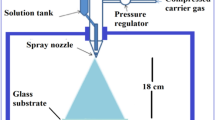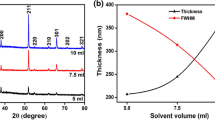Abstract
Transparent conducting fluorine and Sb-doped [SnO2: (F, Sb)] thin films have been deposited onto preheated glass substrates using the spray pyrolysis technique by the various dopant quantity of spray solution. The effect of antimony impurities on the structural, morphological, electrical, Thermo-electrical, optical and photoconductive properties of films has been investigated. The [F/Sn] atomic concentration ratio (x) in the spray solution is kept at value of 0.7 and the [Sb/Sn] atomic ratio (y) varied at values of 0, 0.0005, 0.001, 0.002, 0.01, 0.03, 0.05, 0.07 and 0.10. It is found that the films are polycrystalline in nature with a tetragonal crystal structure corresponding to SnO2 phase having orientation along the (110) and (200) planes. SEM images indicated that nanostructure of the films has a particle type growth. The average grain size increases with increasing spraying quantity of Sb-dopant. The compositional analysis of SnO2: (F, Sb) thin films were studied using EDAX. SEM and AFM study reveals the surface of SnO2: (F, Sb) to be made of nanocrystalline particles. The Hall Effect measurements have shown n-type conductivity in all deposited films. The lowest sheet resistance and highest the carrier concentration about 7.7 Ω/□ and 6.6 × 1022, respectively, were obtained for the film deposited with y = [Sb/Sn] = 0.001 and x = [F/Sn] = 0.7. The maximum of the Seebeck coefficient equal to 12.8 μV K−1 was obtained at 400 K for the film deposited with y = [Sb/Sn] = 0.10. The average transmittance of films varied over the range 10–80 % with change of Sb-concentration. The band gap values of samples were obtained in the range of 3.19–3.8 eV. From the photoconductive studies, the Sb-doped films exhibited sensitivity to incident light especially in y = 0.001. The electrical resistivity and carrier concentration vary in range 5.44 × 10−4 to 1.02 × 10−2Ω cm and 2.6 × 1022–6.6 × 1022 cm−3, respectively.










Similar content being viewed by others
References
T. Ohgaki, R. Matsuokaa, K. Watanabe et al., Synthesizing SnO2 thin films and characterizing sensing performances. Sens. Actuators B 150(1), 99 (2010)
D.P. Joseph, P. Renugambal, M. Saravanan, S.P. Raja, C. Venkateswaran, Thin Solid Films 517, 6129 (2009)
M. Ajili, M. Castagné, N.K. Turki, Study on the doping effect of Sn doped ZnO thin films. Superlattices Microstruct. 53(1), 213 (2013)
K. Murakami, K. Nakajima, S. Kaneko, Initial growth of SnO2 thin film on the glass substrate deposited by the spray pyrolysis technique. Thin Solid Films 515(24), 8632 (2007)
S. Calnan, A.N. Tiwari, Review: high mobility transparent conducting oxides for thin film solar cells. Thin Solid Films 518, 18391849 (2010)
B.J. Ingram, G. Bgonzalez, D.R. Kammler, M.I. Bertoni, T.O. Mason, Chemical and structure factors governing transparent conducting in oxide. J Electro Ceram. 13, 167–175 (2004)
C.T. Mias, C. Sakonas, C. Oswald, An Investigation into the Feasibility of Designing Frequency Selective Windows Employing Periodic Structures (The Nottingham Trent University: Radiocommunications Agency, Nottingham, 2006)
C. Ararat Ibarguen, A. Mosquera, R. Parra, Synthesis of SnO2 nano particles through the controlled precipitation route. Mater. Chem. Phys. 101, 433–440 (2007)
J. Montero, J. Herrero, C. Guillen, Preparation of reactively sputtered Sb-doped SnO2 thin films: structural, electrical and optical properties. Sol. Energy Mater. Sol. Cells 94, 612 (2010)
T. Gui, L. Hao, J. Wang et al., Structure and features of SnO2 thin films prepared by RF reactive sputtering. Chin. Opt. Lett. 8(s1), 134 (2010)
M. Bhagwat, P. Shah, V. Ramaswamy, Synthesis of nano crystalline SnO2 powder by amorphous citrate route. Mater. Lett. 57, 1604–1611 (2003)
M. Ristic, M. Ivanda, S. Popovic, S. Music, Dependence of nanocrystalline SnO2 particle size on synthesis route. J. Nano Cryst. Solids 303, 270–280 (2002)
J.E. Song, Y.S. Kang, Synthesis of indium tin oxide nano particles and application to near IR-reflective film. Mater. Res. Soc. Symp. Proc. 818, 1–14 (2004)
C. Velasquez, M.L. Ojeda, A. Campero, Surfactantless synthesis and textural properties of self-assembled mesoporous SnO2. Nanotechnology 17, 3347–3358 (2006)
X.T. Zhou, F.M. Heigl, W. Murphy, T.K. Sham, T. Regier, R.I.R. Blyth, Time-resolved X-ray excited optical luminescence from SnO2 nanoribbons: direct evidence for the origin of the blue luminescence and the role of surface states. Appl. Phys. Lett. 89(21), 213109 (2006)
R.C. Budhani et al., Magnetotransport in epitaxial films of the degenerate semiconductor Zn1−xCoxO. J. Phys. Condens. Matter 17, 75–86 (2005)
S.A. Chambers et al., Ferromagnetism in oxide semiconductors. Mater. Today 9(11), 28–35 (2006)
M.-M. Bagheri-Mohagheghi, N. Shahtahmasebi, M.R. Alinejad, A. Youssefi, M. Shokooh-Saremi, Fe-doped SnO2 transparent semi-conducting thin films deposited by spray pyrolysis technique: thermoelectric and p-type conductivity properties. Solid State Sci. 11, 233–239 (2009)
D.R. Lide, CRC Handbook of Chemistry and Physics, 86th edn. (CRC Press, Boca Raton, 2005). ISBN 0-8493-0486-5
K.K. Purushothaman, M. Dhanashankar, G. Muralidharan, Curr. Appl. Phys. 9, 67 (2009)
Author information
Authors and Affiliations
Corresponding author
Rights and permissions
About this article
Cite this article
Mokaripoor, E., Bagheri-Mohagheghi, MM. Effect of very low to high Sb-doping on the structural, electrical, photo-conductive and thermoelectric properties of fluorine-doped SnO2 (FTO) thin films prepared by spray pyrolysis technique. J Mater Sci: Mater Electron 27, 2305–2314 (2016). https://doi.org/10.1007/s10854-015-4026-8
Received:
Accepted:
Published:
Issue Date:
DOI: https://doi.org/10.1007/s10854-015-4026-8




